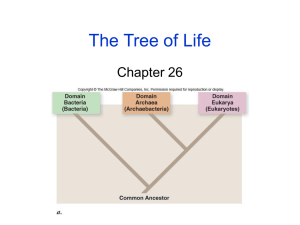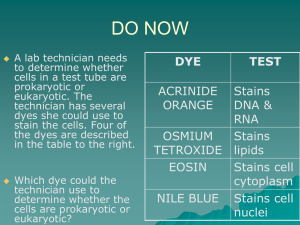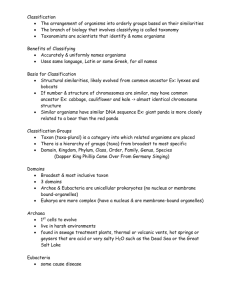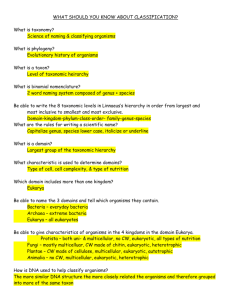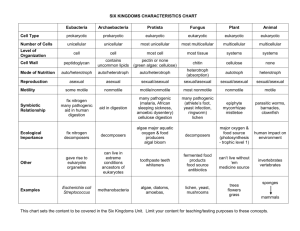chapters 1 & 18 pptol
advertisement
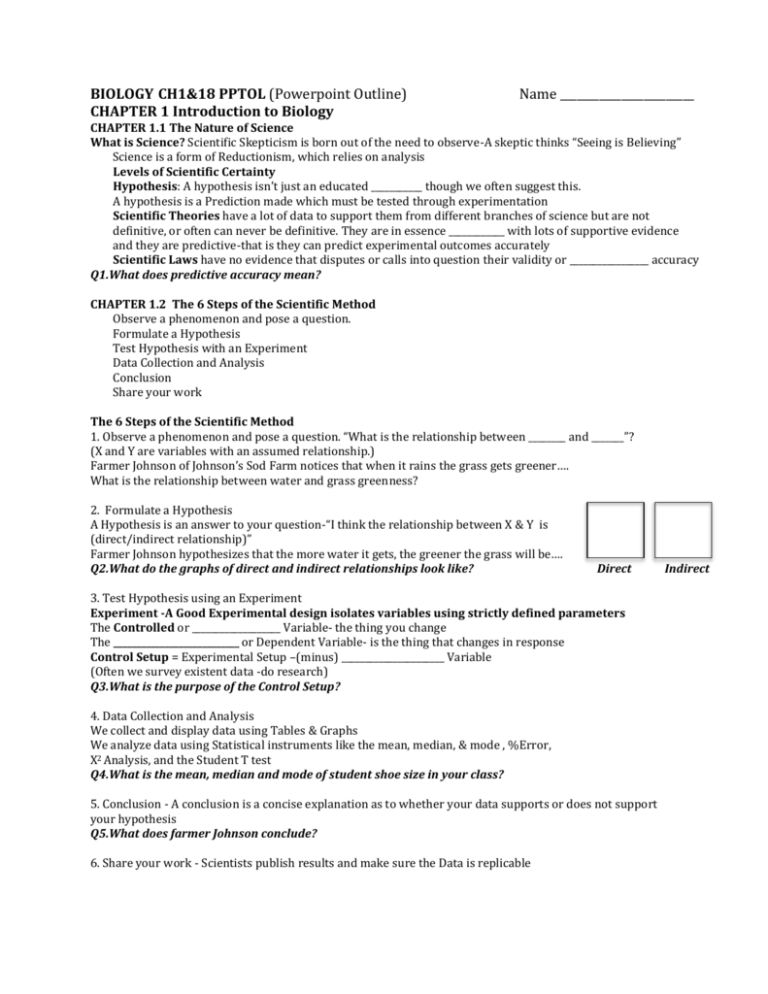
BIOLOGY CH1&18 PPTOL (Powerpoint Outline) CHAPTER 1 Introduction to Biology Name ________________________ CHAPTER 1.1 The Nature of Science What is Science? Scientific Skepticism is born out of the need to observe-A skeptic thinks “Seeing is Believing” Science is a form of Reductionism, which relies on analysis Levels of Scientific Certainty Hypothesis: A hypothesis isn’t just an educated ___________ though we often suggest this. A hypothesis is a Prediction made which must be tested through experimentation Scientific Theories have a lot of data to support them from different branches of science but are not definitive, or often can never be definitive. They are in essence ____________ with lots of supportive evidence and they are predictive-that is they can predict experimental outcomes accurately Scientific Laws have no evidence that disputes or calls into question their validity or _________________ accuracy Q1.What does predictive accuracy mean? CHAPTER 1.2 The 6 Steps of the Scientific Method Observe a phenomenon and pose a question. Formulate a Hypothesis Test Hypothesis with an Experiment Data Collection and Analysis Conclusion Share your work The 6 Steps of the Scientific Method 1. Observe a phenomenon and pose a question. “What is the relationship between ________ and _______”? (X and Y are variables with an assumed relationship.) Farmer Johnson of Johnson’s Sod Farm notices that when it rains the grass gets greener…. What is the relationship between water and grass greenness? 2. Formulate a Hypothesis A Hypothesis is an answer to your question-“I think the relationship between X & Y is (direct/indirect relationship)” Farmer Johnson hypothesizes that the more water it gets, the greener the grass will be…. Q2.What do the graphs of direct and indirect relationships look like? Direct 3. Test Hypothesis using an Experiment Experiment -A Good Experimental design isolates variables using strictly defined parameters The Controlled or ___________________ Variable- the thing you change The ___________________________ or Dependent Variable- is the thing that changes in response Control Setup = Experimental Setup –(minus) ______________________ Variable (Often we survey existent data -do research) Q3.What is the purpose of the Control Setup? 4. Data Collection and Analysis We collect and display data using Tables & Graphs We analyze data using Statistical instruments like the mean, median, & mode , %Error, X2 Analysis, and the Student T test Q4.What is the mean, median and mode of student shoe size in your class? 5. Conclusion - A conclusion is a concise explanation as to whether your data supports or does not support your hypothesis Q5.What does farmer Johnson conclude? 6. Share your work - Scientists publish results and make sure the Data is replicable Indirect CHAPTER 1.3 Tools and Techniques The Metric System- is based on root 10 or decimal system Important Suffixes to know Kilo (k) = 1000 Deci (d ) = 1/10 Centi (c) = 1/100 Milli (m)= 1/1000 Micro(m) = 1/100000 Nano (n) = 1/1000000000 Q6. How many cm in 1mile? We measure the following quantities Mass = __________ g Length = meter m Temperature = oC (oCelsius) Volume solid = meter3 Volume liquid =__________ l 5280ft= 1 mile 1ft=12in 1inch=2.54cm SHOW FACTOR LABEL!! CHAPTER 1.4 What is Biology? Its the study of life ! Other Branches of Biology include…(this is a short, very incomplete list) Biochemistry- macromolecules like proteins, lipid, carbohydrates, and nucleic acids Cytology- the study of cells, cell types, their structures and metabolism Genetics- the study of inherited traits Microbiology – the study of unicellular organisms, archaebacteria , eubacteria, protists and fungi Evolution- the study of the change in species over time Botany – plants Zoology – animals Ecology – the relationship between living and nonliving Q7. What do you think an Ethnobiologist studies? A Cryptozoologist? The 7 Characteristics of Living things All organisms share these common characteristics (CHRRGM!!!) Cellular Organization- unicellular v. multicellular, and prokaryotic v. eukaryotic Homeostasis- the maintenance of a stable internal environment __________________________ – pass traits form parent to offspring via DNA Reproduction- asexual v. sexual Response- homeostasis, irritability, evolution Metabolism- the cycling of matter and energy Growth and Development- cell division and cell differentiation The 7 Characteristics of Living things Cellular Organization: All living things are composed of ______________ Organisms may be unicellular or multicellular Cells are the basic unit of structure and function Organisms may be prokaryotic or eukaryotic Homeostasis: The maintenance of a stable internal environment Q8. Define the following with Examples: Thermoregulation: Gas exchange: Hydration: Blood glucose: Heredity: The passing of traits from parent to _____________________________ via DNA Reproduction: Sexual Reproduction- Involves the combination of Gametes or Sex Cells Asexual Reproduction - Involves the simple splitting of one organism into two Response: Behavior-An individuals response to the environment Evolution- A species response to the environment Metabolism: The cycling of matter and energy Growth & Development: Growth – occurs through cell division or Mitosis Development- occurs through cell _______________________________ Chapter 18 Taxonomy & Classification CHAPTER 18.1 THE NEED FOR SYSTEMS Why do biologists have taxonomic systems? Common names like frog and worm don’t tell us enough information Common names are misleading Common names vary from country to country Biologists use taxonomic systems to organize their knowledge of organisms. About 1.7 million species have been named but millions more are undiscovered. The practice of naming and classifying organisms is called taxonomy. Biologists group organisms into large categories as well as more specific categories known as a taxon (plural, taxa). Early Classification Systems The Ancient Philosopher Aristotle divided living things into 2 groups- Plants and Animals Carl Linnaeus in the 1750s. introduced a two-word naming system called BINOMIAL NOMENCLATURE .made up of two Latin terms for the GENUS and SPECIES SCIENTIFIC NOMENCLATURE AKA BINOMIAL NOMENCLATURE System is used to give each organism its SCIENTIFIC NAME the genus name and a single descriptive word for each species. Naming Rules:The unique, two-part name for a species is now called a scientific name. No two species can have the same scientific name. All the members of a genus share the genus name as the first term. The second term is called the species identifier, and is often descriptive. When you write the name, the genus name should be capitalized and the species should be lowercase. Both terms should be italicized. The Modern Classification System or Modern Taxonomy THE LINNAEAN SYSTEM Uses Binomial nomenclature (2 names) Developed by Carolus Linneaus in 18th century Organisms organized by structural features The Eight basic levels of Modern Classification are domain, kingdom, phylum, class, order, family, genus, & species. Levels of the Modern Linnaean System -Each taxon is identified based on shared traits. -Similar species are grouped into a genus; similar genera are grouped into a family; and so on up to the level of domain. -All living things are now grouped into one of three domains. -A species is defined as a unique group of organisms so similar they reproduce to form viable offspring The Modern Taxonomy Domain, Kingdom, Phylum, Class, Order, Family, Genus, Species Did King Phillip Come Over For Good Soup?... You try one EXAMPLE: Lion’s Taxonomy DOMAIN Eukarya KINGDOM Animalia PHYLUM Chordata CLASS Mammalia ORDER Carnivora FAMILY Felidae GENUS Panthera SPECIES leo Scientific Name Panthera leo Classification of Life Kingdoms of Life In the PAST we used the 5 Kingdom system to classify life… Monera - Bacteria Protista - “Pond Scum, Animacules” Fungi - Mushrooms. Molds, Yeast Plantae - Plants Animalia - Animals EXAMPLE: Man’s Taxonomy DOMAIN KINGDOM PHYLUM CLASS ORDER FAMILY GENUS SPECIES Scientific Name Eukarya Animalia Chordata Mammalia Primate Hominidae Homo sapiens Homo sapiens The 3 Domains of Life Today we use The Modern Taxonomy Archae - Ancient Prokaryotes Bacteria - Modern Prokaryotes Eukarya – Protista, Fungi, Plants, & Animals Protista –Zooplankton & Phytoplankton Fungi – Molds, Yeasts & Mushrooms Plantae – Flowering Plants, Conifers, Ferns & Mosses Animalia - Sponges, Jellyfish, Worms, Insects, Fish, Mammals, & Birds DOMAIN: Archae ORGANIZATION: Unicellular CELL TYPE: Prokaryotic NUTRITION: Autotrophic- Chemosynthetic REPRODUCTION: Asexual (some rare “sexual’) MOVEMENT: Cilia or Flagella ENVIRONMENT: Aquatic or Terrestrial - Extreme Environments MISCELLANY: Extreme Environments-Ice, Rock, Acid, and even your guts EXAMPLES: Methanogens, Sulfur Bacteria, Halophiles, ThermoAcidophiles, DOMAIN: Eubacteria ORGANIZATION: Unicellular CELL TYPE: Prokaryotic NUTRITION: Autotrophic and Heterotrophic REPRODUCTION: Asexual (some rare “sexual exchange’) MOVEMENT: Cilia or Flagella ENVIRONMENT: Aquatic or Terrestrial MISCELLANY: Hey, They can mess you up jack!!! EXAMPLES: +Streptococcus, +Staphylococcus, E. coli, - Salmonella, -Gonnorhea,- Cyanobacteria DOMAIN: Eukarya Kingdom: Protista ORGANIZATION: Unicellular (a few Multicellular) CELL TYPE: Eukaryotic NUTRITION: Heterotrophic or Autotrophic REPRODUCTION: Sexual and Asexual MOVEMENT: Cilia or Flagella ENVIRONMENT: Aquatic or Terrestrial MISCELLANY: Some eat bacteria EXAMPLES: Amoeba, Algae, Diatoms, & Paramecium DOMAIN: Eukarya Kingdom: Fungi ORGANIZATION: Unicellular OR Multicellular CELL TYPE: Eukaryotic NUTRITION: Heterotrophic REPRODUCTION: Sexual and Asexual MOVEMENT: Some ENVIRONMENT: Terrestrial MISCELLANY: Decomposers EXAMPLES: Mold, yeast, rusts & mushrooms DOMAIN: Eukarya Kingdom: Plantae ORGANIZATION: Multicellular CELL TYPE: Eukaryotic NUTRITION: Autotrophic REPRODUCTION: Sexual (& some Asexual) MOVEMENT: Geotropism& Phototropism ENVIRONMENT: Aquatic or Terrestrial MISCELLANY: Insects aid in pollination EXAMPLES: Mosses, Ferns, Shrubs, Trees, Flowering Plants & (Algae??) DOMAIN: Eukarya Kingdom: Animalia ORGANIZATION: Multicellular CELL TYPE: Eukaryotic NUTRITION: Heterotrophic REPRODUCTION: Sexual (Some Asexual) MOVEMENT: At some Stage ENVIRONMENT: Aquatic & Terrestrial MISCELLANY: 106 species of Arthropods alone!! EXAMPLES: Sponges, Jellyfish, Worms, Insects, Fish, Mammals, & Birds


